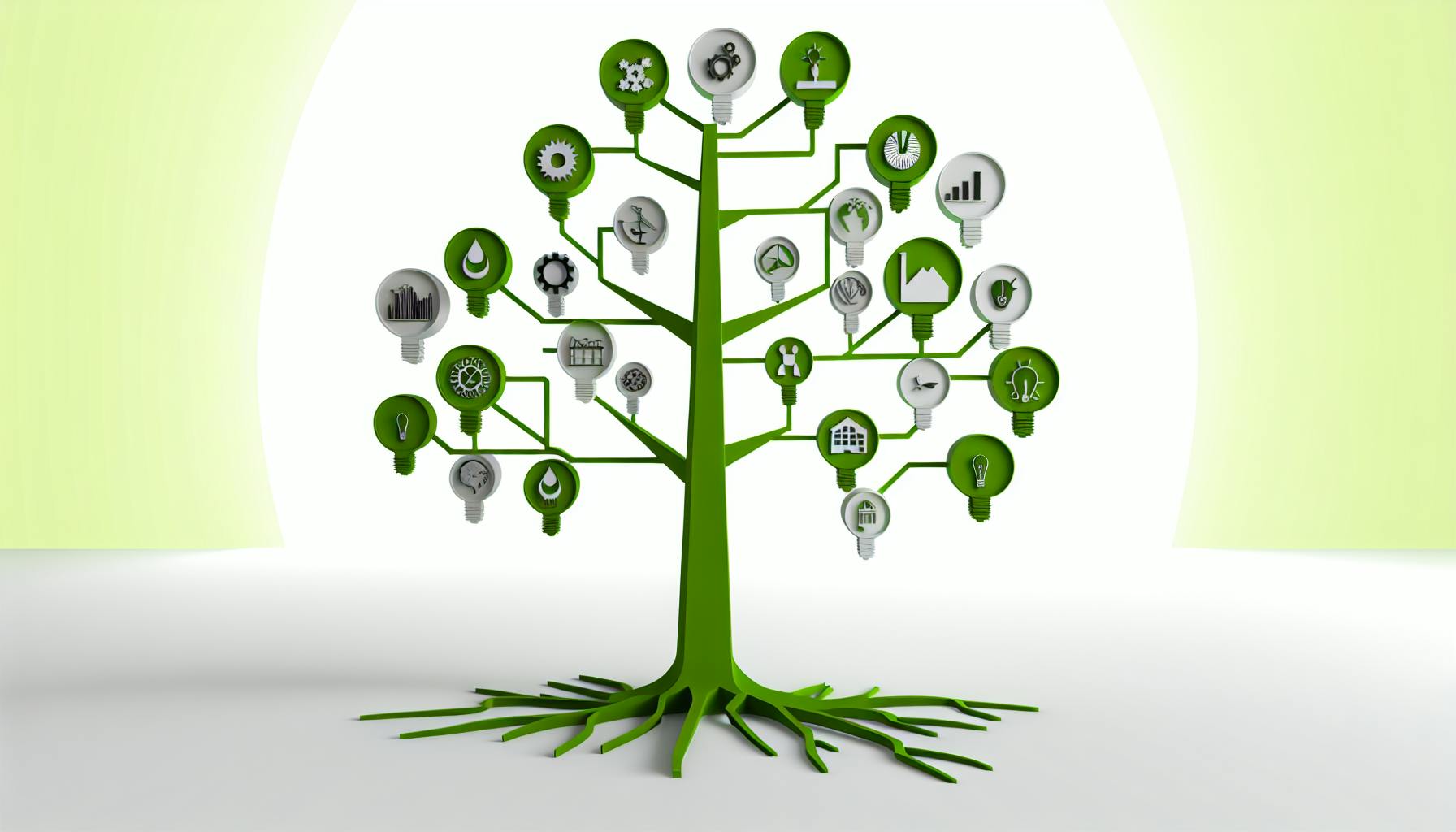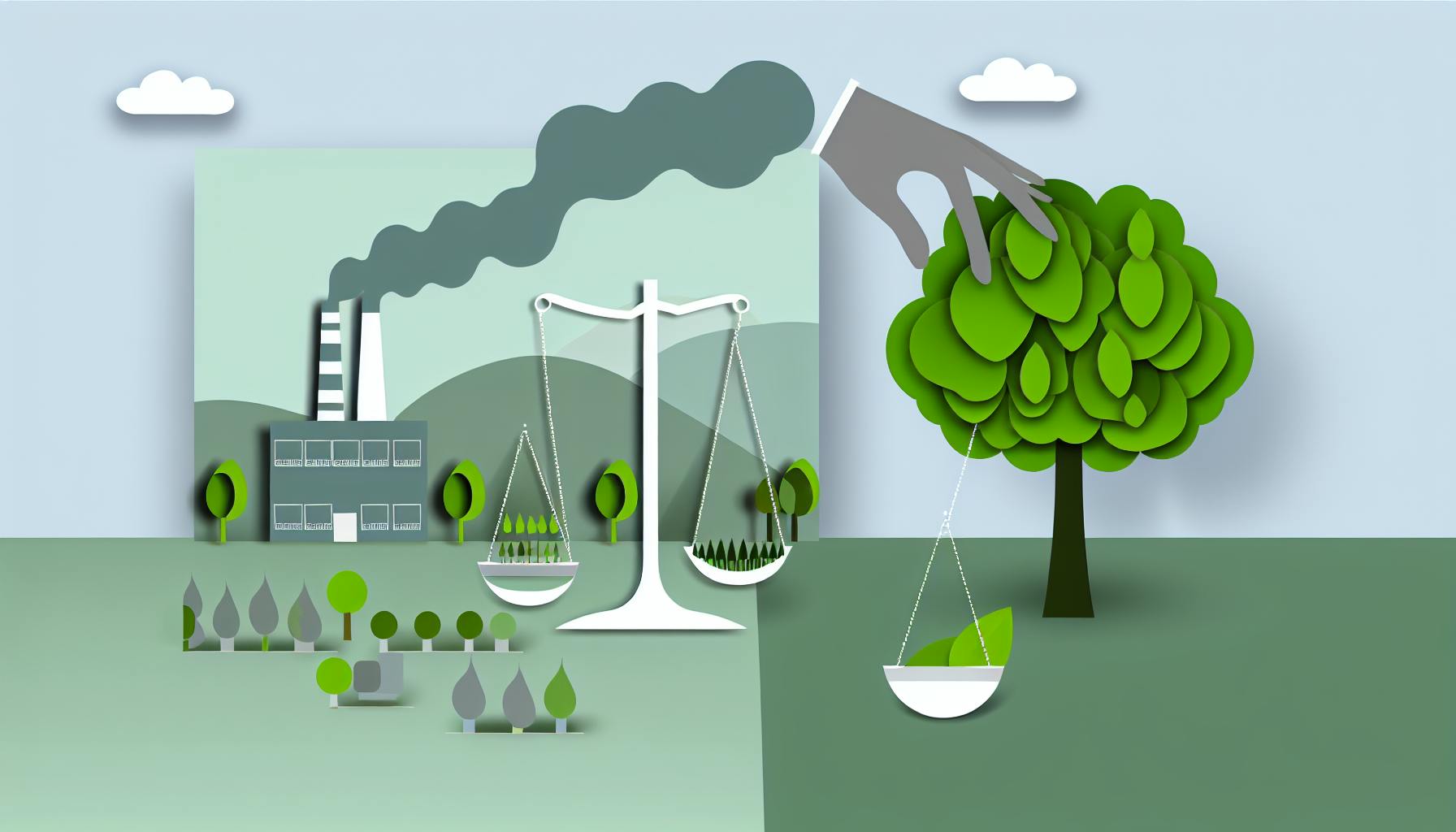Reporting scope 3 emissions poses valid challenges for SMEs.
This article explores practical strategies that SMEs can employ to accurately measure and disclose scope 3 emissions.
We'll examine real-world examples, common issues SMEs face, and actionable methods to streamline scope 3 accounting - enabling sustainable growth.
Introduction to Scope 3 Carbon Emissions and Climate Change
Scope 3 emissions refer to indirect greenhouse gas emissions from a company's value chain. They can account for a significant portion of an organization's carbon footprint. Understanding and reporting scope 3 emissions is key for businesses aiming to mitigate their climate impact.
Accurately tracking scope 3 emissions presents challenges, especially for small and medium enterprises (SMEs) with complex supply chains. However, reporting scope 3 emissions helps:
- Identify emission hotspots to focus reduction efforts
- Engage suppliers and partners on sustainability practices
- Meet stakeholder and regulatory disclosure requirements
- Contribute to climate change mitigation by shrinking value chain emissions
Decoding Scope 1, 2 & 3 Emissions: A Diagrammatic Explanation
To clarify, scope 1 covers direct emissions from owned or controlled sources like facilities and vehicles. Scope 2 accounts for indirect emissions from purchased electricity and heating.
Scope 3 emissions encompass all other indirect emissions occurring across the company's entire value chain - from raw materials, transportation, distribution, business travel to product use and disposal.
The Expanded View of Scope 3 Carbon Emissions
Scope 3 emissions provide a comprehensive view of a company’s carbon impact. They can account for over 80% of total emissions for many businesses.
For example, an apparel firm’s scope 1 and 2 emissions may pale in comparison to the aggregate emissions from materials production, manufacturing, logistics, laundry, and disposal.
As stakeholders demand transparency and action on climate change, accurately tracking scope 3 emissions helps companies identify risks, opportunities and reduction pathways.
Navigating the Scope 3 Categories: Real-world Insights
The Greenhouse Gas Protocol delineates 15 categories of scope 3 emissions. Let's examine category 1 - purchased goods and services.
For a food delivery firm, the emissions from food transport and packaging likely dominate its carbon footprint. By switching to eco-friendly packaging and optimizing delivery routes, it can shrink scope 3 emissions substantially.
For a software company, the embedded emissions in purchased cloud computing services may comprise a major share of scope 3 emissions. It can collaborate with cloud providers to procure renewable energy and lower-emission infrastructure.
Careful scope 3 analysis uncovers emission hotspots and avenues for engagement across the value chain. Tight stakeholder scrutiny means SMEs must surmount scope 3 tracking challenges to spearhead climate action.
What is scope 3 emission?
Scope 3 emissions refer to all indirect greenhouse gas emissions that occur across a company's value chain. Unlike scope 1 and 2 emissions which cover direct and energy-related emissions, scope 3 captures all other indirect emissions associated with business operations.
Some common examples of scope 3 emissions sources include:
- Employee commuting and business travel
- Transportation and distribution of products
- Waste disposal
- Extraction and production of purchased materials
- Use of sold products
- End-of-life treatment of sold products
For instance, for a clothing manufacturer, scope 3 emissions would encompass the following:
- Emissions from cotton farming
- Textile production at supplier facilities
- Transportation of raw materials and finished products
- Washing and drying of clothes by consumers
- Disposal at landfills
So even though these emissions are produced by third parties along the supply chain, they are classified as scope 3 because they occur as a consequence of the company's activities.
Accurately tracking scope 3 emissions can be challenging due to complex supply chains and lack of reliable data. However, understanding your complete carbon footprint is key to developing an impactful decarbonization strategy aligned with climate goals.
What are material scope 3 emissions?
Scope 3 emissions refer to greenhouse gas emissions that are a consequence of a company's activities, but occur from sources the company does not own or control. These indirect emissions are often more difficult to calculate and track compared to scope 1 and 2 emissions.
Some examples of scope 3 emissions sources include:
- Transportation and distribution of products purchased by the company
- Business travel by employees
- Waste disposal
- Use of sold products by consumers
- Transportation of products sold by the company
Figuring out which scope 3 emissions are most relevant or "material" for a company to track can be challenging. Generally, the largest sources of scope 3 emissions that a company can influence or work with partners to reduce are considered material.
For an online retailer, key material scope 3 emissions might include:
- Emissions from delivery/distribution of products
- Packaging production
Whereas for a software company, material scope 3 emissions could include:
- Business travel
- Emissions from purchased cloud services
Establishing a full scope 3 inventory, then honing in on the most material emission sources based on the company's operations and influence can help SMEs efficiently report and reduce indirect emissions over time.
What are scope 3 emissions issues?
Scope 3 emissions refer to indirect greenhouse gas emissions that occur in a company's value chain. Unlike scope 1 and 2 emissions that companies have direct control over, scope 3 emissions happen upstream and downstream of their operations and are usually the largest share of a company's carbon footprint.
Some key issues companies face with scope 3 emissions are:
- Data gaps - Companies rely on suppliers and partners to provide emissions data which is often incomplete or inaccurate. Without robust data, estimation methodologies for scope 3 emissions may be unreliable.
- Complex to measure - Scope 3 emissions encompass many categories like purchased goods, transportation, waste disposal etc. Tracking all these sources requires significant coordination across the value chain.
- Harder to reduce - Companies have limited influence over scope 3 activities that fall outside their operational control. Reducing scope 3 emissions involves close collaboration with external stakeholders which can be challenging.
However, addressing scope 3 emissions is crucial for companies aiming to align with 1.5°C climate goals. Some effective strategies include:
- Engaging suppliers to calculate and disclose emissions
- Switching to low carbon materials or transportation
- Incentivizing customer behavioral changes
Getting scope 3 measurement and reporting right is key to making progress on value chain decarbonization. Robust data and coordination with partners is essential to overcome existing barriers.
sbb-itb-919600f
What is an example of upstream emissions scope 3?
Let's explore an illustrative example of upstream scope 3 emissions. Consider a company called CleanCo that manufactures eco-friendly cleaning products.
When assessing their carbon footprint, CleanCo may identify the following upstream scope 3 activities:
- Raw material extraction & processing - Emissions from extracting raw ingredients like plant oils and processing them before being sent to CleanCo's manufacturing facilities.
- Inbound transportation - Transporting raw materials and product components from suppliers to CleanCo on trucks, rail, ships, etc.
By including upstream scope 3 emissions from their value chain, CleanCo gets a more complete view of emissions they indirectly impact. This enables them to collaboratively find solutions upstream to reduce overall emissions.
For context, downstream scope 3 emissions occur when customers use CleanCo's products after purchase. But accurate measurement of upstream activities comes first in understanding total lifecycle impact.
Dissecting the Complexities of Scope 3 Emissions for SMEs
Small and medium-sized enterprises (SMEs) play a pivotal role in combating climate change. However, quantifying scope 3 emissions poses a complex challenge for many SMEs due to factors like limited resources and difficulties in acquiring supplier data. This article delves into practical examples and solutions to overcome these hurdles.
The Puzzle of Data Collection for Scope 3 Emissions
Scope 3 emissions refer to indirect emissions across an organization's entire value chain. This makes data collection an intricate puzzle, as SMEs need to account for emissions from diverse sources like raw material suppliers, transportation providers, product distribution channels, and more.
For example, an SME selling consumer goods might source raw materials from farms in Asia and Africa, manufacture products in Eastern Europe, and sell to customers globally - encompassing a vast supplier network. Tracking emissions across such a sprawling supply chain can be a herculean task.
However, robust supplier data is crucial for calculating accurate scope 3 emissions and enabling science-based target setting. As Julie Nash, Director of Foods and Forests at Ceres, explains, "If a company really wants to calculate its scope 3 emissions, it has to engage its suppliers to report their scope 1 and scope 2 emissions."
So overcoming data gaps is paramount. Industry associations like CDP and SBTi are equipping SMEs with supplier engagement initiatives and emissions factor databases to facilitate precise carbon accounting across complex value chains.
Methodological Maze: Simplifying Scope 3 Calculations
In addition to supply chain data puzzles, the diversity of scope 3 emissions methodologies itself can overwhelm SMEs. Protocols like the GHG Protocol Corporate Value Chain (Scope 3) Standard, PAIA, and PEFCRs employ differing boundary setting principles, allocation methods, emissions factors, and materiality assessments.
This can make identifying the most suitable approach for one's business ecosystem quite tricky. For example, a UK-based fabric manufacturing SME exporting globally had to assess methodologies from DEFRA, BEIS, and IPCC before determining the EX-ACT tool as best suited for calculating emissions from sourcing African organic cotton.
However, by leveraging expert guidance and emissions calculation tools tailored for SMEs, organizations can overcome such complexity barriers more seamlessly today. Resources like APO's SME Guidebook Series, SME Climate Hub's Carbon Calculator, and GHG Protocol's Sector Guidance simplify methodology selection and emissions calculations for SMEs through sector-specific recommendations.
Budgets and Bandwidth: Overcoming Resource Limitations
Tracking scope 3 emissions also requires investments in staff bandwidth, working capital, and tools like Life Cycle Analysis software which are often cost-prohibitive for SMEs.
However, SMEs like Alter Eco and Tony's Chocolonely demonstrate that sustainability leadership is very much achievable on a small budget through clever workarounds. By creatively tapping into industry networks and pro-bono support to conduct hotspot analyses, these chocolate brands quantified upstream emissions from cocoa farming practices. This enabled science-based target setting and supply chain engagement initiatives to drive down Scope 3 emissions.
Such examples highlight the power of collective climate action through industry coalitions like SME Climate Hub. By pooling resources and expertise, even SMEs with limited internal bandwidth can overcome barriers in scope 3 emissions measurement.
In summary, scope 3 emissions quantification unlocks immense potential for SMEs to combat climate change through science-based decarbonization initiatives across their entire value chain. While data, methodology, and resource challenges exist, practical solutions and collaborative opportunities are increasing for SMEs today to overcome these barriers.
Blueprint for Tackling Scope 3 Emissions Reporting
Scope 3 emissions refer to indirect greenhouse gas emissions from sources not owned or controlled by a company but related to its operations. These emissions often represent the majority of an organization's carbon footprint and can be challenging to measure and report. Small and medium-sized enterprises (SMEs) in particular may struggle with tracking scope 3 emissions across complex supplier networks and value chains.
However, addressing scope 3 is becoming increasingly important for companies aiming to achieve net-zero emissions goals and satisfy stakeholder demands for climate action. By taking a strategic approach focused on the most material sources of scope 3, tapping into industry-specific resources, and collaborating across value chains, SMEs can enhance the accuracy and completeness of their emissions data.
Zeroing in on Material Scope 3 Categories
Carefully evaluating scope 3 emissions to identify the most significant categories for your operations is key to an efficient mitigation strategy. Assessing suppliers based on emissions volume and reduction potential allows SMEs to prioritize influence where it matters most.
For example, a services firm may find employee commuting, business travel, and purchased goods dominate scope 3 impacts. By contrast, the major scope 3 contributors for a manufacturer likely sit upstream in purchased goods or downstream in product end-of-life. Concentrating efforts here can yield better returns on investment through supplier engagement programs or product/service redesign.
Harnessing Industry-Specific Carbon Accounting Tools
Sector-specific carbon accounting tools and methodologies calibrated to common business activities can assist SMEs tracking scope 3 emissions. Resources like the GHG Protocol Value Chain Standard, SBTi Sector Guidance, and industry-focused carbon calculators simplify otherwise complex accounting for indirect emissions.
For instance, an IT services firm can leverage SBTi's ICT Sector Guidance to model scope 3 from areas like product use and end-of-life. For a consumer goods producer, tools like THE GHG Protocol Product Life Cycle Accounting Standard provide methods to assess emissions across upstream and downstream value chains. Industry-specific factors shine light on scope 3 data quality.
Forging Value Chain Alliances to Enhance Emissions Data
Upstream and downstream partners hold key data needed to complete scope 3 inventories. By collaborating across supply chains and distribution networks, SMEs can access more granular emissions information from material vendors, warehouses, logistics providers and even product consumers.
Joint value chain initiatives could include implementing supplier reporting programs or product carbon labeling schemes. For example, an apparel manufacturer can work with textile partners to install monitoring equipment capturing energy and materials usage in factories. Or a grocery producer might cooperate with retailers to survey customer disposal habits for packaged goods. Pooling scope 3 data across partners provides SMEs a more complete picture for strategy setting and emissions reduction initiatives.
Case Studies: SMEs Leading the Charge in Scope 3 Emissions Reporting
SMEs face an uphill battle when it comes to tracking and reporting Scope 3 emissions from their supply chain and value chain. However, some innovative companies are leading the way and demonstrating best practices. Here are a few case studies of SMEs that exemplify commitment to comprehensive Scope 3 accounting and reporting.
Sustainable Apparel: A UK Fashion Brand's Scope 3 Journey
As part of its net-zero strategy, Ethical Fashions, a UK-based sustainable clothing brand, systematically addressed its Scope 3 emissions. It collaborated with suppliers at every stage - from raw material production to product distribution - to calculate emissions across its value chain.
By mapping its supply chain and working closely with partners, Ethical Fashions quantified emissions related to purchased goods and services. It also tracked downstream transportation and distribution emissions plus emissions from product use and disposal by customers.
Through such scope three carbon emissions examples, Ethical Fashions reduced its annual Scope 3 emissions by 12% in just two years. The fashion brand aims to further lower indirect emissions by 30% by 2025. Its commitment has also motivated other small brands to follow suit.
Organic Growth: A B Corp Food Company's Scope 3 Milestones
As a certified B Corp, The Green Table prioritized sustainability across its whole value chain spanning sourcing, manufacturing, storage and delivery. The organic food company systematically tracked annual emissions across relevant Scope 3 categories.
From accurately quantifying emissions from upstream agriculture to emissions from downstream distribution, The Green Table has set - and achieved - aggressive reduction targets. By engaging transport partners in its net-zero journey and running customer awareness campaigns, the company reduced Scope 3 emissions intensity by over 20% while more than doubling its revenue.
Such measurable actions and scope three emissions examples have made The Green Table an inspiration for small sustainable businesses across the food industry.
Innovation for Impact: Clean Tech Startup's Comprehensive Emissions Inventory
ClimateActionTech, a clean-tech startup offering carbon accounting SaaS solutions, recently completed a comprehensive Scope 3 screening and emissions inventory. It assessed emissions from all 15 Scope 3 categories as per the GHG Protocol and took into account the entire lifecycle of its solutions.
By proactively evaluating emissions from hardware manufacturing to software utilization by customers, ClimateActionTech quantified over 75% of its total emissions footprint. It is implementing a detailed Scope 3 emissions reduction roadmap in line with 1.5°C pathways.
Such a full-scale inventory covering all indirect emissions sources demonstrates ClimateActionTech's commitment to practicing what it preaches. Its journey can motivate other tech startups to follow suit in completeness and transparency.
Through such purpose-driven strategies centered on understanding, reducing and reporting Scope 3 emissions, these SMEs are setting precedents and pushing boundaries in sustainable business. Their stories offer insights and inspiration for small and medium enterprises aiming to achieve net-zero in a comprehensive manner.
Synthesizing Scope 3 Insights for Sustainable Business Practices
As organizations strive for net-zero emissions, accurately measuring and reporting Scope 3 emissions presents a significant challenge. However, by taking a methodical approach, SMEs can gain actionable insights to inform sustainable business practices.
Here is a concise roadmap for SMEs ready to take on Scope 3 emissions management:
- Conduct a hotspot analysis to identify the most carbon-intensive activities across your value chain. This allows you to prioritize high-impact areas.
- Engage suppliers & customers in emissions reductions efforts through incentives, collaborations, or setting shared goals.
- Invest in cleaner technologies like electric vehicles, renewable energy, or lower-carbon materials to reduce supply chain impacts.
- Compensate remaining emissions through verified carbon offsets while continuing to find ways to further avoid and reduce emissions.
- Communicate progress through annual sustainability reports and stakeholder engagement. Celebrate achievements to maintain momentum.
Approaching Scope 3 holistically, while collaborating across value chains, is key to cost-effectively achieving scaleable emissions reductions. The journey may seem daunting initially, but taking purposeful strides today enables organizations to future-proof operations for a net-zero tomorrow.



